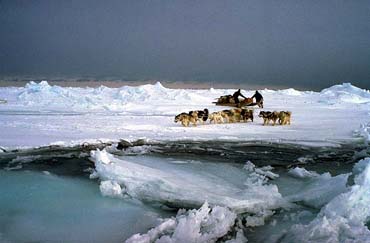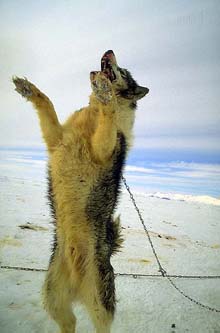Table of Contents
Thanks to our Sponsors
Featured Inuit Dog Owner: Tim Socha
Nunavut Quest 2001
Inuit Dogs in New Hampshire, Part I
Uummannaq: A Special Dog Sledge Expedition
Remembrances of a Spent Life: "Chimo"
Dog News from Iqaluit
The Homecoming, Part III
Fan Hitch Wins Writing Contest Recognition
Product Review: Seeing the Light
Media Review: The Last Husky
Tip for the Trail: A Do-it Yourself Alcohol Heater
IMHO: Looking Forward
Navigating This
Site
Index of articles by subject
Index
of back issues by volume number
Search The
Fan Hitch
Articles
to download and print
Ordering
Ken MacRury's Thesis
Our
comprehensive list of resources
Talk
to The Fan
Hitch
The Fan
Hitch home page
ISDI
home page
Editor: Sue Hamilton
Webmaster: Mark Hamilton
Contents of The Fan Hitch Website and its publications are protected by international copyright laws. No photo, drawing or text may be reproduced in any form without written consent. Webmasters please note: written consent is necessary before linking this site to yours! Please forward requests to Sue Hamilton, 55 Town Line Rd., Harwinton, Connecticut 06791, USA or mail@thefanhitch.org

Corel photo
Iqaluit Still Wrestling with the Issue of Dog Teams
by Geneviève Montcombroux
At a time when a new awareness of the Canadian Inuit Dog is spreading, the town of Iqaluit, capital of Nunavut Territory, which has adopted the Canadian Inuit Dog as its mammal emblem, has tried to ban Canadian Inuit Dog teams from town.
Whenever someone picks up a magazine or a brochure advertising Nunavut, there is invariably the image of a dog team. Isn't it ironic that the capital of the Territory which thus advertises its heritage should be devoid of the famed dog teams? Tourism is the main industry of the Territory and tourists look eagerly around when they reach Iqaluit. Where are the dog teams? That's what two passengers seated behind me asked on my last trip to Iqaluit last September.
If teams continue to be picketed far from town, tourists will not hear the eerie but mystic howl which is such an inherent part of the Arctic. Instead, they will hear the yipping and yapping of stray dogs of undetermined breed roaming the streets. These are the ones that should be controlled. Shouldn't the town support a spaying and neutering program so that pets that escape from their owners cannot reproduce and contribute more dogs to the stray population?
The outcry against the Canadian Inuit Dog teams began with a tragedy. In the middle of the night on the sea ice, a child wandered into the middle of a team. Her parents did not know she was missing. There are measures that can be taken to prevent this situation. Maybe the first one would be to educate children, not only to keep away from dogs, but not to throw stones at them. During one of my visits to Iqaluit, I went beside the airport where some teams were picketed. I arrived on foot and surprised two youths busy throwing stones at a dog who had only the length of its chain to dodge them. The youths ran off at my arrival. Pulling and running on its chain could have caused the snap to break, and this dog would have become loose. The circle would have been complete when the dog catcher would arrive and shoot the "stray" dog.
Besides educating children and adults about the Canadian Inuit Dog, the teams ought to be kept next to the owners' houses so that the owners can keep a close check on the dogs and have permanent access to them - which cannot happen when the dogs are picketed out of town. An enclosure to keep the dogs away from other dogs and people is really the only solution.
As the capital of Nunavut, Iqaluit is growing. People move there from the big southern cities. Some do not understand the Canadian Inuit Dog or what it represents in the culture of the Inuit. Yet Iqaluit has a unique northern flavor. It should be the repository of traditions and Inuit culture.
Mistakes made in the past almost led to the complete demise of this breed which has existed in the Arctic for over 4,000 years. Is the new territory, led by Iqaluit, going to repeat the mistakes of the past? Will the Canadian Inuit Dog go the way of the Talhtan Bear Dog and the Passenger Pigeon? Or will the leaders take enlightened measures to make sure the past does not die but co-exist with modern civilization?
Let's hope that the lawmakers will have the vision to ensure the future, not only of an ancient breed of dog but of a whole culture.

Corel
photo
There is Reason to be Hopeful: Update February 19, 2001
information submitted by Ken MacRury
The situation in Iqaluit is improving. I made the suggestion a number of weeks ago that the Town should have two by-laws, one to deal with the normal animal control issues and the other to be an "Inuit Dog Preservation By-law", wherein the basic intent is to support the preservation of the Inuit Dog as a breed and to assist owners in their efforts rather than harass them.
This was put forward at a Town public meeting on the topic on January 23 and received some support. The dog owners have a small committee that is assisting the Town in drafting a preservation by-law and we have committed to having something for review by the end of February. The Mayor wants this issue resolved and put behind them, and because of that I think we have an opportunity to do something positive for the breed. I am fairly optimistic that we are now on the right track and these efforts will result in a positive outcome. If you could bring any outside support pressure to bear on the Mayor and Council I think it would be useful to what we are trying to accomplish.
Editor's Note: Folks, Ken sees value in our correspondence to the Iqaluit Mayor and Council. Please support this effort with your letters, faxes and e-mails. Here are the people and contact information: John Mathews, Mayor; Rick Butler, Senior Administrative Officer; Neville Wheaton, Emergency Services. They all can be reached by phone at 867-979-5600 or fax 867- 979-5922 or by e-mail at <city.Iqaluit.cao@nunanet.com> or snail mail at P.O. Box 460 Iqaluit, NU X0A 0H0.
* * *
Proposed By-Law on the Table: February 28, 2001
information submitted by Ken
MacRury,
summarized by Sue Hamilton
"WHEREAS public safety is the utmost concern of the Town but the Town also understands that no risk can be absolutely eliminated, only managed through thoughtful regulation and reasonable management..."
The above proclamation is but one of the eight "WHEREAS’s" included in a February 28, 2001 By-law proposed by the Municipality of Iqaluit, capital of Nunavut Territory. And although not yet in officially approved form, it appears that the dim light at the end of what has been a very long and gloomy tunnel may finally turn out to be a burst of sunshine for Canadian Inuit Dogs (CID) and Dog Team Owners. Included in this draft are whereas’s recognizing the CID as endangered with extinction and as being the official mammal of Nunavut, and Dog Team Activities as an integral part of Iqaluit’s unique character as well as playing an important role in economic and tourism development.
This 14-page draft document of nearly 4,000 words
includes language that:
1) defines the Canadian Inuit Dog, Dog Team and Dog Team
Activities,
2) requires vaccination for rabies as well as other
preventable canine diseases,
3) spells out guidelines for defining Designated Dog Team
Areas, exceptions to the keeping of team dogs in said
areas, as well as the process for team owners to apply to
have an area so declared. (In doing so, the importance of
socialization is recognized.) A town supported committee
consisting of a Councilor, two team owners and two members
at large will be appointed to process these applications
and rule on the suitability of these proposed areas.
4) creates rules for the humane care and treatment of team
dogs as well as rules restricting Dog Team Areas to team
owners, their designees and Animal Control Officers
(unless someone is going to the aid of a dog or person in
distress in the area). Cruelty to dogs either on the
part of team owners or trespassers will be punishable
offenses.
5) creates rules for the capture, impounding and
disposition of dog team dogs.
Noteworthy are the absence of the $500,000 liability insurance requirement of dog team owners, and the inclusion of the statement, "dogs that are registered in accordance to this By-law shall be exempt from the Animal Control By-law or any of its successors."
While the "devil may be in the many details", it appears that Iqaluit Mayor John Matthews wants this by-law finalized by the end of March. The expected process is as follows: it will be reviewed by a small working committee of citizens next week and then go to Council for the required three readings. Between the first and second readings it will be open to public review, which is most likely to happen at a public meeting called by the Town. It would then go back to the Council for one more review (second reading) and then the next week go for a final reading and passage.
The outcome of this legislation will be posted on the ISDI web page <http://www.escape.ca/~toadhall/> as soon as it becomes available. Also, look for an update in the next issue of the Fan Hitch.
Once again, thanks go to Iqaluit resident and long time Canadian Inuit Dog team owner Ken MacRury for forwarding the draft By-Law and for providing the time-line for its approval.